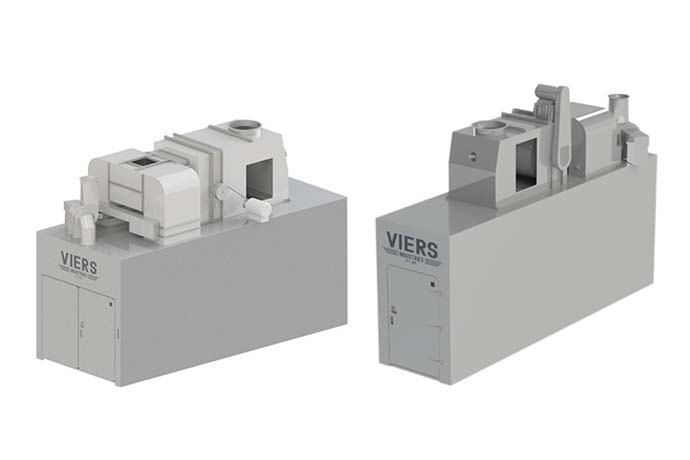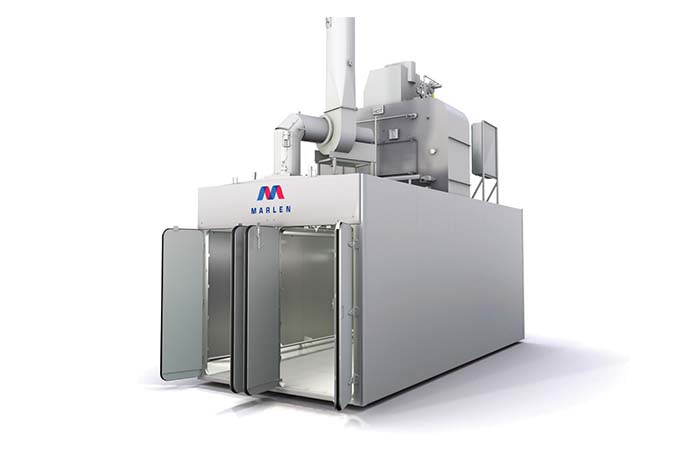The art of smoking meat was born in the traditions of barbecue. Artisan cookers often built their own smokehouses to personal specs and used the species of wood that worked for them and gave them the exact flavors they desired. Today’s commercial smokehouses provide the same nuances and subtleties, but on a large scale and in a more time-efficient manner. Modern commercial smokehouses allow processors to use technology and innovation to bring smoked meats in a packaged and ready-to-eat format to retail and foodservice providers, and ultimately to the consuming public.
Best for barbeque
Most smokehouse manufacturers cite improved control and consistency over airflow throughout the smoking process as a major innovation. While the physical design for controlling how air flows has not changed that much in recent years, the manner in which operators control the airflow has advanced.
“The use of Computational Fluid Dynamics software allows us to model airflow prior to manufacturing to ensure proper airflow and process consistency,” said Marty Wimmer, thermal product line manager at Riverside, Mo.-based Marlen. He added, “Controls have also evolved with HACCP implementation, allowing us to track the who, what, when and why during processing. Controls now also allow us to program air flow for specific products in the same smokehouse.”
Airflow management and control provides ready-to-eat (RTE) barbecue meat processors what they need to supply the best possible products to retailers, distributors and consumers.
“Matching air changes to specific products has become critical,” Wimmer said. “In general, the more air changes you can provide, the more process consistency you can achieve. The key is matching both airflow and the proper type of smoke in order to match the ‘pit flavor’ that is so desirable in barbecue products.”
Processors’ desire to view smokehouse status in real time, adjust on the fly and repeat the process in subsequent batches consistently has also driven development of new and innovative electronic controls.
“The controls we provide on a Viers Industries Smokehouse can range from simple to advanced programming,” said Kit Borer, vice president at Kohler Industries, Lincoln, Neb. “It all depends on what is best for the product and for the customer.”
Borer added, “Getting the right amount of heat and air flow to prep the exterior of the product for the introduction of natural smoke into the cooking chamber via a natural smoke generator is one of the best options for developing that deep smoke flavor in ready-to-eat barbecue meats.”
Burr Ridge, Ill.-based BAK Food Equipment began developing its spiral cooking/smoking/freezing line over 10 years ago. The original models were designed as standalone units to cook bacon evenly in a spiral configuration. The design provided uniform heat distribution and reduced cooking time. Eventually BAK adapted the technology to cook and smoke other meats including ribs, pulled pork, brisket and chicken.
“The spiral line is ideal for ready-to-eat barbecue meats because it offers precise temperature control, consistent cooking times, and even heat distribution,” said Tom Bako, director of business development at BAK. “The system can also smoke products, both liquid smoke drench and natural smoke, and finally chill and or freeze the product. The end product results in RTE meats that can be used for smoking, grilling and roasting, and is particularly effective for large quantities of meat, making it perfect for catering and events.”
 Viers smokehouses from Kohler offer both simple and complex programming giving processors options based on their needs. (Source: Kohler)
Viers smokehouses from Kohler offer both simple and complex programming giving processors options based on their needs. (Source: Kohler)
Nick Brown, smokehouse technology manager for Fusion Tech Integrated, Roseville, Ill., agreed and specified humidity control for consistency from batch to batch. He also noted that RTE barbecue meats need the right look, texture and feel for the highest quality and authenticity.
“Humidity control allows more consistency from batch to batch and allows a more tender product in a shorter time,” Brown said. “Gas burners and hardwood smoke generators are very beneficial in creating the traditional smoke ring and ‘bark’ of the smoked meats, as well.”
Tom Springman, managing partner at Kerres USA, Muncy, Pa., added the ability of higher heating capacity aids in the ability to smoke RTE barbecue products. The higher heating capacity allows for hotter traditional barbecue dry bulb temperatures. In addition, Springman said customers still want to create higher humidity to reduce cook times and increase yields and yet be able to optimize drying when necessary.
“We are able to smoke at higher temps, thus replicating traditional pit houses,” he said. “All while having control capacity to optimize drying processes to mimic the bark or the opportunity for barking up the product if desired.”
Safety matters
Michael Kapps, national sales manager at AmTrade Systems Inc. based in Livonia, Mich., said innovations and new technologies in commercial smokehouses also include labor reduction and sanitation. Automated systems now move products through the chambers with less handling by human labor. Design improvements provide easier and more thorough cleaning with less points of harborage for microbes.
“One of the main changes in recent years is the implementation of sanitary design principles,” Kapps said. “The construction materials and design of smokehouses and ovens have changed in ways to make them more robust, to better withstand the cleaning chemicals used in food processing plants today, and to ensure that all corners and hidden, hard-to-reach locations within the smokehouse and oven can be thoroughly cleaned.”
Not only do RTE barbecued meats require effective air handling control, but they also need a wide variance of air-control options to prevent cold spots and ensure uniform heating.
“An effective heating system uses indirect steam heating or direct gas heating with added humidity, and an oven that has an integrated CIP (clean in place) system and sanitary design features (since these products are usually open and exposed when cooked),” Kapps said.
Smokehouse manufacturer Alkar, Lodi, Wis., is a subsidiary of Elgin, Ill.-based Middleby Food Processing. Vice president at Alkar, Steve King, added, “When it comes to RTE barbecued meats, Alkar’s traditional processes allow customers to cook their products to perfection using the combination of state-of-the-art airflow and recipe development that delivers consistent flavor and color.”
Alkar achieves the consistency it finds necessary for RTE barbecue by striving to build smokehouses that generate repeatability in temperature, color and yield. “Intel-A-Flow” servo controlled damper systems give customers the confidence to hit their smoking targets through utilization of the FLeX Control system to monitor temperatures ensuring their products surpass all safety and quality standards.
 Marlen builds custom smokehouses making communication throughout the purchasing process imperative. (Source: Marlen)
Marlen builds custom smokehouses making communication throughout the purchasing process imperative. (Source: Marlen)
Discussion before delivery
Equipment manufacturer and processor partnerships that work well and find the best solutions begin with communication. Processors want reliability and performance in all equipment, but communicating the finer details to a supplier plays a major role in complete satisfaction. When deciding on a smokehouse used for RTE barbecue it’s imperative to let potential partners know exactly what is needed.
“Our customers know their products and processes better than we do,” Borer said. “At Kohler Industries, we start by listening to what our customers need and want. From there, we are able to use our knowledge of equipment to suggest a custom solution. And with in-house engineers, electricians, machinists, and fabricators, we can deliver a full team to client consultations.”
Marlen designs custom smokehouses for its customers. The company must consider the products, processes and facilities when putting together specific solutions according to what a partner needs to produce the highest quality equipment it can.
“Understanding the customer’s needs and wants is the first step in delivering a successful project,” Wimmer said.
Manufacturing teams can gain a deep understanding of a processor’s wants and needs by asking the right questions and listening with thoughtfulness. Then they can advise in a deliberate manner. By listening with this intention, a company may be able to provide certain solutions to problems a processor might not have been aware of.
“The most important thing to do is to gain a complete understanding of the customer’s products, processes and goals for the new equipment,” Kapps said. “Finding out how they currently process their products, what they like about their current equipment, and what problems they experience allows us to propose the best solutions.”
Alkar uses its experience in building smokehouses in conjunction with their customers’ long- and short-term goals. This communication in tandem with research and development, and engineering builds a platform for collaboration with all the various individuals and teams involved in a smokehouse project. Every aspect of a new smokehouse, including commissioning, training, installation and product validation takes place in the field to ensure customer satisfaction.
“Alkar’s dedicated project management team works closely with the customers from the beginning of the sales process to successful installation and commissioning of each smokehouse,” King said. “They take a collaborative approach working with a customer’s engineering, quality assurance, plant management and production staff to ensure any unique features or challenges related to installation and training are covered at the beginning of the project — eliminating potential challenges on the backend.”
Brown emphasized acquiring every bit of knowledge possible during every process from beginning to end. From the initial sales process through purchase and installation through long-term maintenance, a complete understanding of product portfolio, actual needs and end-product, among other points, are imperative for manufacturers to provide complete solutions.
“Overall logistics and attention to details, even the small ones, are critical during installation,” Brown said. “During installation the location of oven placement, utility requirements and capabilities are very important facts to know. After installation and commissioning, the customer’s preventative maintenance schedule is very important to follow. It is what keeps their ovens working at an optimal level with minimal downtime.”
At Kerres, a detailed exchange of information is mandatory for a smooth process and to ensure any obstacles and challenges are known in real time. This way, any situation that might arise in the process can easily be overcome.
“Proper information, and clear direction to the customer and the installer throughout the process is the key to smooth commissioning,” Springman said.



